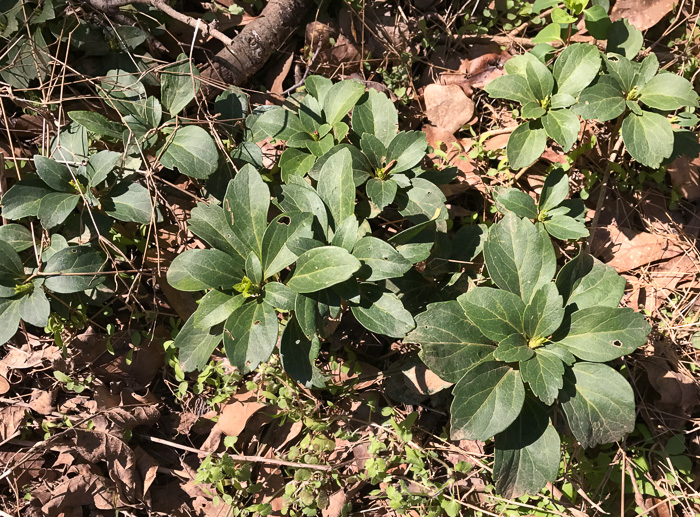Spermatophytes (seed plants): Angiosperms (flowering plants): Eudicots: Buxales
WEAKLEY'S FLORA OF THE SOUTHEASTERN US (4/14/23):
Pachysandra terminalis
FAMILY
Buxaceae
Go to FSUS key
Dig deeper at SERNEC, a consortium of southeastern herbaria.
Check out EDDMapS.org to see where this has been reported.
Learn more about Pachysandra from the Vascular Plants of North Carolina.
A popular ground-cover, difficult to eradicate once established, per Weakley's Flora (2022)
SYNONYMOUS WITH
PLANTS NATIONAL DATABASE:
Pachysandra terminalis
FAMILY
Buxaceae
SYNONYMOUS WITH Flora of North America north of Mexico, vol. 10 (2021)
Pachysandra terminalis
SYNONYMOUS WITH Floristic Synthesis of North America. BONAP (Kartesz, 2021)
Pachysandra terminalis
SYNONYMOUS WITH Floristic Synthesis of North America (Kartesz, 1999)
Pachysandra terminalis
SYNONYMOUS WITH VASCULAR FLORA OF THE CAROLINAS (Radford, Ahles, & Bell, 1968) 108-01-002:
Pachysandra terminalis FAMILY Buxaceae
COMMON NAME:
Pachysandra, Japanese-spurge
To see larger pictures, click or hover over the thumbnails.
JK Marlow jkm180315_0592
March Greenville County SC
Lake Conestee Nature Park
Leaves coriaceous, evergreen, glabrous, dark green, per Weakley's Flora (2022).
WEAKLEY'S FLORA OF THE SOUTHEASTERN US (4/14/23):
Pachysandra terminalis
FAMILY
Buxaceae
SYNONYMOUS WITH
PLANTS NATIONAL DATABASE:
Pachysandra terminalis
FAMILY
Buxaceae
SYNONYMOUS WITH
Flora of North America north of Mexico, vol. 10
Pachysandra terminalis
SYNONYMOUS WITH
Floristic Synthesis of North America. BONAP (Kartesz, 2021)
Pachysandra terminalis
SYNONYMOUS WITH
Floristic Synthesis of North America (Kartesz, 1999)
Pachysandra terminalis
SYNONYMOUS WITH
VASCULAR FLORA OF THE CAROLINAS (Radford, Ahles, & Bell, 1968) 108-01-002:
Pachysandra terminalis
FAMILY
Buxaceae
If a search such as "Carex leptalea var. leptalea" doesn't deliver the results you want, try "Carex leptalea".
Or, to minimize chances of a misspelling, try just "Carex le".
Less is more: If "pencil flower" doesn't deliver the results you want, try "pencil".


